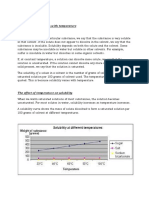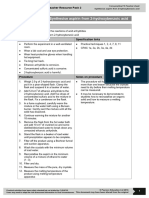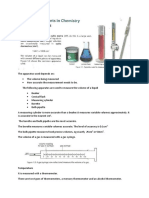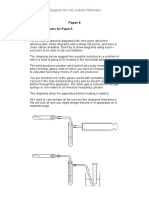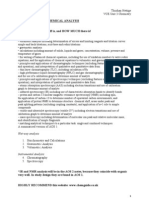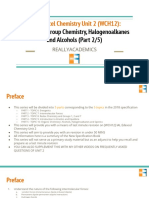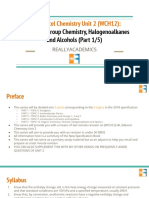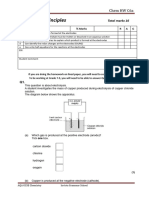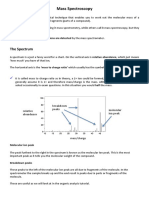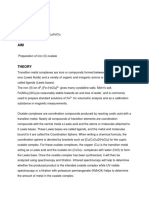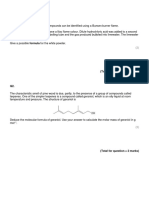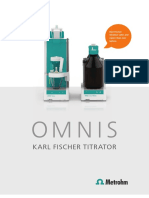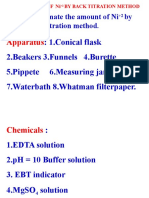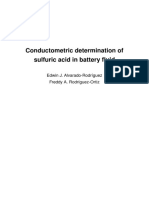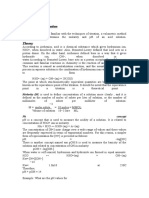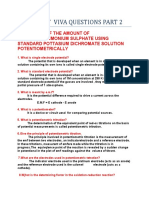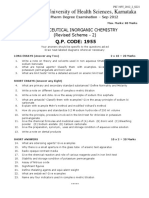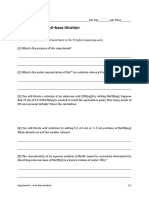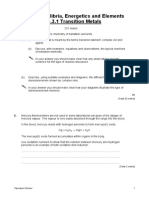0 ratings0% found this document useful (0 votes)
97 viewsp5 Tips
p5 Tips
Uploaded by
Ch PengThis document provides guidance for students taking the CHEM Paper 5 exam, including:
1. When drawing diagrams for experiments, always specify the volume of apparatus used to avoid proposing unrealistic volumes.
2. Use burettes or pipettes for small volume measurements to minimize percentage error, which is important for Paper 5 questions.
3. Strongly heated crystals should be placed in a crucible on a clay triangle, not a test tube, to avoid cracking. Allow the crucible to cool before weighing.
4. Titration provides an accurate method for analysis because the endpoint is sharp and percentage errors from pipettes and burettes are small.
Copyright:
© All Rights Reserved
Available Formats
Download as DOCX, PDF, TXT or read online from Scribd
p5 Tips
p5 Tips
Uploaded by
Ch Peng0 ratings0% found this document useful (0 votes)
97 views10 pagesThis document provides guidance for students taking the CHEM Paper 5 exam, including:
1. When drawing diagrams for experiments, always specify the volume of apparatus used to avoid proposing unrealistic volumes.
2. Use burettes or pipettes for small volume measurements to minimize percentage error, which is important for Paper 5 questions.
3. Strongly heated crystals should be placed in a crucible on a clay triangle, not a test tube, to avoid cracking. Allow the crucible to cool before weighing.
4. Titration provides an accurate method for analysis because the endpoint is sharp and percentage errors from pipettes and burettes are small.
Original Description:
bio p5
Original Title
p5 tips
Copyright
© © All Rights Reserved
Available Formats
DOCX, PDF, TXT or read online from Scribd
Share this document
Did you find this document useful?
Is this content inappropriate?
This document provides guidance for students taking the CHEM Paper 5 exam, including:
1. When drawing diagrams for experiments, always specify the volume of apparatus used to avoid proposing unrealistic volumes.
2. Use burettes or pipettes for small volume measurements to minimize percentage error, which is important for Paper 5 questions.
3. Strongly heated crystals should be placed in a crucible on a clay triangle, not a test tube, to avoid cracking. Allow the crucible to cool before weighing.
4. Titration provides an accurate method for analysis because the endpoint is sharp and percentage errors from pipettes and burettes are small.
Copyright:
© All Rights Reserved
Available Formats
Download as DOCX, PDF, TXT or read online from Scribd
Download as docx, pdf, or txt
0 ratings0% found this document useful (0 votes)
97 views10 pagesp5 Tips
p5 Tips
Uploaded by
Ch PengThis document provides guidance for students taking the CHEM Paper 5 exam, including:
1. When drawing diagrams for experiments, always specify the volume of apparatus used to avoid proposing unrealistic volumes.
2. Use burettes or pipettes for small volume measurements to minimize percentage error, which is important for Paper 5 questions.
3. Strongly heated crystals should be placed in a crucible on a clay triangle, not a test tube, to avoid cracking. Allow the crucible to cool before weighing.
4. Titration provides an accurate method for analysis because the endpoint is sharp and percentage errors from pipettes and burettes are small.
Copyright:
© All Rights Reserved
Available Formats
Download as DOCX, PDF, TXT or read online from Scribd
Download as docx, pdf, or txt
You are on page 1of 10
CHEM Paper 5 Notes
Dealing with Question 1
For planning section:
1. When asked to draw a diagram, ALWAYS mention the volume of the apparatus being used. The one
most often used is gas syringe. I think it is better to limit the volume of syringe to less than 500 cm3 .
Also, the volume of a commonly used small test tube is around 16 cm3 and that of a boiling tube is
about 25 cm3. We always have to keep the volume of the apparatus we are using while choosing the
volume of the solution for the planning. Saying that we are going to place 50cm3 of aqueous HCl in a
test tube is of course not going to please the examiners. I think I ended up doing the same in one of the
papers where we had to prepare different concentrations of a given solution. I chose volume of water to
be added to a beaker to be 250 cm3. However, the ER stated that twhe volume should be less than
200cm3, that so being since the volume of a commonly used glass beaker is around 250cm3. Someone
carrying out my expm would have a fully filled beaker. However, we can use greater volume if we state
that the volume of the beaker is 400cm3 or 500 cm3 or so on. So, stating the volume of the apparatus is
very very important
2. Always while measuring volume of solutions, use burette or pipette because they have low
PERCENTAGE error. The question of percentage errors are usually asked in P5. The percentage error
becomes very unacceptable if we are measuring SMALL volumes of solution or small masses. So, a 3dp
balance is much better for measuring masses than a 2dp balance as it would have much less % error
when small masses are being measured
3. While heating crystals strongly, do not use a simple test tube or any apparatus with sharp edges as
they are liable to crack at the sharp edges. For very strong heating to a constant mass, a crucible placed
on a pipe clay triangle is appropriate. And of course to measure the mass of the crucible + solid, you
would have to place it on a balance. But we wouldnt want to fry our poor balance by placing a very hot
crucible on top of it. So, allow the crucible to cool for a few minutes by placing it on a heat mat.
When using a magnesium ribbon or any dirty surface, clean it with SANDPAPER
How to prepare crystals (which is also linked with solubility)
Many methods are mentioned in MS but I found this to be the simplest:
CIE usually demands us to prepare crystal after preparing a saturated solution of the crystal.
So, we have to prepare a saturated solution first:
1. Take a fixed volume of water in a beaker of appropriate volume
2. Add the crystal to the water and stir continuously. You have to allow some time for the crystal to
dissolve as it is an equilibrium process
3. After 5 min of stirring , if no solid crystals appear, add further mass of crystal
4. And repeat the process until solid appears in the beaker
5. Filter the solution using a filter paper and funnel so that the saturated solution is collected in a
beaker(whose mass has been measured previously) beneath the funnel
Now we have a saturated solution in a beaker.
How to get the crystals:
1. We have to place the beaker in a warm water bath. We could use a burner as well but there is a risk of
overheating the solution which could decompose the crystal. If the heat is appropriate, the water of the
solution should evaporate and we should have dry crystals ready.
How to measure solubility:
6. Measure the mass of beaker + solution from step 5
7. Subtract the mass of beaker from the mass in 6 to get the mass of saturated solution
8. And evaporate as shown above to get the mass of crystals.
8. Measure the mass of crystal + beaker
9. Subtract mass of beaker from mass in 8 to get the mass of crystals
10. Subtract the mass of crystals from the mass of saturated solution to get the mass of water in the
solution
11. I have assumed that all the masses are in grams. So, to get the solubility: Mass of crystal x 100/Mass
of waterq
When you have to remove moisture from :
1. Surface:
Wash the surface with a stream of propanone. The water gets dissolved in the propanone and repeat it
multiple times. Then gently heat the surface to evaporate the propanone from the surface
2. Vapour:
Use dessicants such as:
1. ANHYDROUS sulphuric acid
2. ANHYDROUS calcium chloride
3. Silica gel
You have to pass the vapour from the beaker containing the dessicant
Also, a useful property of soda lime is that it absorbs BOTH water vapour and carbon dioxide
We are also regularly asked to measure enthalpy changes
Most of us already know that we use a plastic cup and thermometer for this purpose
However this has many disadvantages (asked regularly) and here are some of them with the required
measures:
1. Heat loss to the surroundings from the beaker:
To avoid this:
a. Cover the plastic cup with a lid
b. Place the cup in a beaker. The air in the beaker acts a good insulator.
c. Use multiple cups so as to thicken the lateral layer of plastic
2. Instability of the cup
a. Place the cup in a glass beaker
3. For exothermic reactions, spray of the solution very likely
a. Use a large beaker to carry out the experiment rather than the small plastic cup (which has a small
volume)
b. Put a lid on the top of the beaker (this only MINIMISES the spray, doesnt prevent it totally)
4. When we are heating a volume of water in glass beaker, there are two cases of heat loss to consider:
a. Heat loss from the beaker of water
b. Heat loss from the burner heating the volume of water
When preparing a solution of a fixed concentration from a given parent solution of concentration , say,
2.0 mol/dm3
A. We are required to prepare a solution of concentration of 1.0 mol/dm3 with volume 250 cm3 ( the
conc cannot be greater than 2 !!!!!!!!!!!!!!)
a. Add 100 cm3 of the parent solution to a volumetric flask of marking at 250 cm3
b. Top off with water to the mark of 250 cm3. Use a wash bottle for this purpose to have greater control
over the addition process
When required to prepare 250 cm3 of 0.5 mol/dm3 solution of a crystal of Mr 50g
First realize that we need only 250 cm3, not 1 dm3
Now in 250 cm3 there will be: 50/4 = 12.5 g of the solid
So, first add 12.5 g of solid to 50 cm3 of water in a BEAKER ( not the volumetric flask yet). Also note that
the volume of water is less than 250 cm3.
Stir properly and if the solid doesnt dissolve add more water until it fully dissolves
Then transfer the solution from the beaker to a volumetric flask. Remember to rinse the beaker with
water and transfer the solution to the volumetric flask
Stopper the flask and shake properly
Finally, add the required volume of water to make the solution upto 250 cm3 USE A FUNNEL OR YOU
RISK OVERSHOOTING THE MARK
Titration is accurate because:
1. Standard solution of acid/base is used
2. we obtain concordant titres
3. % error in pipette and burette is very small
4. The end point of a titration is sharp
How to draw a solubility curve for a solid ?
Weigh an empty boiling tube. Add some water in the tube. Weigh the tube again. Add some of the solid
in the tube and weigh. Heat the boiling tube gently and stir so that all solid dissolves. Allow the water to
cool and measure the temperature at which first crystals appear. This experiment will be repeated for
different masses of water and solid. The graph for (solubility against temperature) is the solubility
curve.
Solubility : Mass of Solid dissolved in 100 grams of water.
How to ensure no gas is lost when reagents are mixed in a flask/container ?
WRONG METHOD : Putting the reagents together and quickly putting the bung.(this too will allow some
gas to be released). The use of thistle funnels is also inappropriate as as when some liquid is added
through the funnel. The system isnt sealed. The liquid run into the flask will displace an equivalent
amount of air from the apparatus.
Use of Divided Flasks : The below flask is used to keep the reagents apart. Put the bung on with the
delivery tube collecting gas in the syringe or over water. And shake so that the reagents come into
contact with each other and thus no gas escapes.
Methods of Collecting Gas
Disadvantage of gas collected over water. The gas should be insoluble in water. Even if insoluble, some
of the gas dissolves in water thus the correct volume of gas released cannot be determined. Syringe is
better in collecting the gas.
How to separate an undissolved solid from a solution?
Wet a filter paper and then adjust it onto a funnel. Drop the solution gradually into the funnel. The
undissolved solid will collect at the residue. The solution will be collected in a beaker placed under the
funnel.
How to condense steam released from a flask.
Attach a liebig condenser to the flask so that the steam is condensed and place a test tube at the end of
the condenser to collect the water (from the condensed steam).
A reaction in a flask releases Gas A and steam. You have to collect the steam as
water. And measure the amount of Gas A released .
The whole system should be sealed. Attach a liebig condenser to the flask to condense the steam and
use a delivery tube that collects the condensed steam as water in an airtight test tube. After this has
occurred there should be another delivery tube (that should be placed after the liebig condenser) which
is connected to a gas syringe to measure the volume of Gas A. Note the system should be sealed. So that
no gas escapes.
Diagrams of Apparatus:
Separating Funnel
A Water Bath ( Used to keep a required temperature of the vessel. Does not reach very high
temperatures.)
1
Lie Big Condenser
Dealing with Question 2
Two points about data tables are common every session. Firstly, candidates need to label
each new column
used. These labels require three items a written label, a correct unit and an expression to
be used to
calculate the column data. All of these items are required for credit to be awarded (often the
expression is
omitted). Secondly, the data needs to be correctly quoted, to either a specified number of
decimal places or
significant figures. In this examination, the data requirement was for 3 significant figures.
Usually, the table
head and data requirements are given below the table, so candidates should be advised to
look there before
calculating any data.
In scaling the axes on a graph plot, candidates should always consider if the true origin (0,0)
would be a
point on the line. If so, it should always be included in the scales since it would always be a
reliable, correct
point. Two factors need to be taken into account when scaling the axes. The points need to
be plotted
within at least half of each axis and the scale should be reasonable to facilitate accurate
plotting. For
example data of 1, 2, 4 or 5 to 1 large square (of 10 small squares) would be reasonable but 3
or 6 or 7 to 1
large square (of 10 small squares) would not. Some candidates would benefit from practice
in fitting a
reasonable scale into the grid first that uses at least half of each axis.
When referring to the reason for an anomalous result, it should be stressed to candidates
that they
unambiguously define the point (e.g. Experiment 4) before stating a reason. This is vital
when there is more
than one anomaly.
For tables:
Each column heading needs three things, a description (e.g. concentration of acid in water),
a unit
(e.g. /mol dm-3) and an expression to calculate the data (e.g. B x 0.1/20) as required in the
text
below the table.
Also below the table is stated a requirement for a specific number of significant figures or
decimal
places. There is a general misunderstanding of the difference between significant figures,
decimal
places and trailing zeros. In this case the requirement was for three significant figures.
There was
a frequent misunderstanding of this requirement. For example, 0.0105 (3sig figs.) was given
as
0.011 (3dp), even to the extent of seeing 0.0105 written but crossed out and replaced by
0.011
where, presumably, the candidate believes three decimal places is the same as three
significant
figures. Also a calculated value of 0.05 needs to reported as 0.0500 if three significant
figures are
required. Care needs to be taken with the reporting of data.
The two required columns involved a great deal of calculation. Each column required the
calculation of moles of sodium hydroxide, converting this into moles of succinic acid then a
concentration of acid. Only the more able candidates had any success here. Many managed
two
parts of these calculations but usually not the 2:1 relationship between succinic acid and
sodium
hydroxide. This may have been due to unfamiliarity with succinic acid or its formula. Quite
a
significant minority labelled the columns moles of sodium hydroxide rather than
concentration in
each solvent even though this was stated below the table.
For graph plotting:
The scaling of the axes seems to cause misjudgement in the minds of some candidates.
There
seems to be a determination to cover the whole span of the grid regardless of the
implications of
the axis scaling necessary to achieve that. An example of difficult scaling is 1 large square
being
0.03. This would make each small square (1 mm) 0.003. This creates difficulties for the
candidate
in correctly plotting data of the nature of 0.00552 so mis-plotting is often seen when such
inconvenient scales are chosen. Another example of difficult scaling was a 1 mm square
being
0.00218 on the x-axis and 0.000223 on the y-axis. Such scales require the extensive use of a
calculator to adequately plot the data which in the very least may take some time. Some
candidates chose a scale for the acid concentration in water that did not accommodate all
the
points giving the last point outside the grid. The scaling chosen must adequately cover the
available grid but the minimum requirement is for the plot to cover at least half of the grid
in both
directions. So the candidates must make a compromise between scaling and grid coverage to
use
at least half of the grid in both directions with a reasonable scale that can be easily used.
Much
better scaling for the concentration in the water layer would have been 1 large square for
0.0125 or
0.02 mol dm-3 (depending on which axis) and for the concentration in the ether layer, 1
large square
for 0.001 mol dm-3.
Two more factors need to be considered in graph work. Firstly it is the independent variable
that is
to be plotted on the x-axis and the dependent on the y-axis. Almost uniquely in this
particular
question either variable could be plotted on either axis. Secondly the data/relationships
should
always be examined to see if the origin (0,0) is a valid point. If so (as in this question) then
the
scaling used must include the origin and any line drawn would include the origin since it
would be a
definite point not subject to any experimental error as the other points may be.
A requirement for determining a slope is the use of construction lines on the plot to produce
co-ordinates for the slope calculation. Many candidates did not draw construction lines.
..
NOTE : The following points/information regarding p5 have been collected from various
sources/websites and examiner reports. We hope the notes might have improved your
Chemistry Paper 5 Skills.
All the Best!
You might also like
- Chapter 12-Gravimetric Methods of AnalysisDocument13 pagesChapter 12-Gravimetric Methods of AnalysisDianna Dayawon64% (14)
- AOAC Method Ascorbic Ac 967 21 PDFDocument2 pagesAOAC Method Ascorbic Ac 967 21 PDFEdgardo Sanchez GutierrezNo ratings yet
- Chemsheets As 062 (Practical Guide) (1) - See NowDocument6 pagesChemsheets As 062 (Practical Guide) (1) - See NowPrincess KimNo ratings yet
- As Edexcel Markscheme Unit 1Document268 pagesAs Edexcel Markscheme Unit 1Ahmed HeshamNo ratings yet
- Mgo LabDocument3 pagesMgo Labapi-336093393No ratings yet
- Chemistry Handout How Solubility Changes With Temperature SolubilityDocument16 pagesChemistry Handout How Solubility Changes With Temperature SolubilityAnderson MichelleNo ratings yet
- Practical SkillsDocument64 pagesPractical Skillsraghava12345650% (2)
- Chemistry Paper 5Document6 pagesChemistry Paper 5Sashank Aryal0% (1)
- Practical Guide Edexcel2Document42 pagesPractical Guide Edexcel2Hady JawadNo ratings yet
- Chemistry Paper 5 TipsDocument5 pagesChemistry Paper 5 TipsFiaz medico100% (7)
- AS Level Chemistry Practical Paper 3: TitrationDocument12 pagesAS Level Chemistry Practical Paper 3: TitrationAbrar ShariarNo ratings yet
- CH # 2 Experimental Techniques in ChemistryDocument10 pagesCH # 2 Experimental Techniques in ChemistryRana Hassan TariqNo ratings yet
- A Level Chemistry Core Practical 16 - AspirinDocument5 pagesA Level Chemistry Core Practical 16 - Aspirinelsiesaveena96No ratings yet
- Chemistry o Level NotesDocument11 pagesChemistry o Level NotesThaboooNo ratings yet
- Chemguide - CIE A Level Chemistry Support - Paper 5 - DiagramsDocument4 pagesChemguide - CIE A Level Chemistry Support - Paper 5 - DiagramsLister HorekaNo ratings yet
- CLEAPPS Student Safety SheetsDocument105 pagesCLEAPPS Student Safety SheetsQuan nguyen minhNo ratings yet
- Physics Paper 6 NotesDocument7 pagesPhysics Paper 6 Notesbali16molaNo ratings yet
- Chemistry Unit 4 Notes: 4.1 Rates of ReactionsDocument36 pagesChemistry Unit 4 Notes: 4.1 Rates of ReactionssarawongNo ratings yet
- Symbol Equations You Need To Be Familiar WithDocument3 pagesSymbol Equations You Need To Be Familiar WithKamrul Alam MasumNo ratings yet
- IGCSE Chemistry Revision Notes SampleDocument1 pageIGCSE Chemistry Revision Notes SampleAbdelmoneim Elmansy IgcseNo ratings yet
- Edexcel Biology IGCSE: 2.12: Enzymes and TemperatureDocument3 pagesEdexcel Biology IGCSE: 2.12: Enzymes and TemperatureahmedNo ratings yet
- Data BookletDocument8 pagesData BookletSamiha Mahmud100% (1)
- Chemistry Edexcel As Keywords Unit 1Document4 pagesChemistry Edexcel As Keywords Unit 1Ashan BopitiyaNo ratings yet
- Ionisation Energy EdexcelDocument5 pagesIonisation Energy EdexcelKevin The Chemistry Tutor100% (1)
- Chemistry AOS1 Unit 3 NotesDocument34 pagesChemistry AOS1 Unit 3 NotesAnonymous oqlnO8e0% (1)
- Chemistry Unit 2 Part 2 ReallyacademicsDocument26 pagesChemistry Unit 2 Part 2 ReallyacademicsWill Andy100% (1)
- Chemistry Unit 2 Part 1 ReallyacademicsDocument42 pagesChemistry Unit 2 Part 1 ReallyacademicsWill AndyNo ratings yet
- ECR as-AL Chemistry 9701 P2 v4Document50 pagesECR as-AL Chemistry 9701 P2 v4Haram TanveerNo ratings yet
- 9.2 Volumetric Analysis PDFDocument24 pages9.2 Volumetric Analysis PDFJoaquinNo ratings yet
- Practical Paper 3 NotesDocument22 pagesPractical Paper 3 NotesSuperRuhalNo ratings yet
- Thermochemistry (Important Notes)Document2 pagesThermochemistry (Important Notes)HenrySeowNo ratings yet
- Chem-Study - Transition A Level WorkDocument47 pagesChem-Study - Transition A Level WorkAdeeba AbdullahNo ratings yet
- Chemistry Pp6 RevisionDocument7 pagesChemistry Pp6 RevisionArqam MuhammadNo ratings yet
- Cie Igcse Chemistry 0620 Atp v2 ZnotesDocument23 pagesCie Igcse Chemistry 0620 Atp v2 ZnotesSia BhadraNo ratings yet
- Grade 9-Chem. Elements, Compounds and MixturesDocument5 pagesGrade 9-Chem. Elements, Compounds and MixturesMusfira zaibNo ratings yet
- N-Levels: 2014 Chemistry Notes For Secondary School Combined ChemistryDocument44 pagesN-Levels: 2014 Chemistry Notes For Secondary School Combined ChemistryAnnie Tan100% (1)
- 9702 P5 Q1Document4 pages9702 P5 Q1Michael LeungNo ratings yet
- C6a HW - Electrolysis PrinciplesDocument4 pagesC6a HW - Electrolysis PrinciplesAvaani MalhanNo ratings yet
- Unit 5 Chemistry NotesDocument58 pagesUnit 5 Chemistry NotesRabiat100% (1)
- Kwame Nkrumah University of Science and Technology: Glassware: A Statistical StudyDocument8 pagesKwame Nkrumah University of Science and Technology: Glassware: A Statistical StudyJIEHASMARTNo ratings yet
- Preparation of Standard Solution of Sodium CarbonateDocument6 pagesPreparation of Standard Solution of Sodium Carbonateكاظم عقيل كاظم C3No ratings yet
- Caie A2 Chemistry 9701 Theory v3Document33 pagesCaie A2 Chemistry 9701 Theory v3Aditya Drolia100% (1)
- Tutor Next Door O Level Chemistry (6092) Summary Notes 1 Experimental ChemistryDocument4 pagesTutor Next Door O Level Chemistry (6092) Summary Notes 1 Experimental ChemistryArvin LiangdyNo ratings yet
- Transport in Plants (Vascular Bundle)Document6 pagesTransport in Plants (Vascular Bundle)Ahmed Kaleem Khan NiaziNo ratings yet
- Igcse Chemistry Section 4 Lesson 4Document48 pagesIgcse Chemistry Section 4 Lesson 4alanoud obeidatNo ratings yet
- Reversible ReactionsDocument39 pagesReversible ReactionsUsmaanNo ratings yet
- Chemistry Unit 3B NotesDocument13 pagesChemistry Unit 3B NotesShuchi HossainNo ratings yet
- A2 ChemDocument81 pagesA2 ChemJana Mohamed100% (1)
- O Level Chemistry NotesDocument195 pagesO Level Chemistry NotesZarah Tahir60% (5)
- Chemistry Program DPDocument2 pagesChemistry Program DPMBOTAKE Lawson100% (1)
- Flametest PDFDocument2 pagesFlametest PDFChecaina RistonNo ratings yet
- Solutions and Volumetric Analysis 202122Document48 pagesSolutions and Volumetric Analysis 202122yk y小头No ratings yet
- Mass Spectroscopy EdexcelDocument3 pagesMass Spectroscopy EdexcelKevin The Chemistry Tutor100% (1)
- Exothermic and Endothermic ReactionsDocument5 pagesExothermic and Endothermic ReactionsSehyun OhNo ratings yet
- Topic 8.1 IB ChemistryDocument36 pagesTopic 8.1 IB ChemistryFrank AlfanoNo ratings yet
- DefinitionsDocument6 pagesDefinitionsali ahsan khanNo ratings yet
- List of Definition in Chemistry F4Document7 pagesList of Definition in Chemistry F4Lil' Nyeh100% (1)
- Atomic Structure Power PointDocument144 pagesAtomic Structure Power PointKasman Kasonde MumbaNo ratings yet
- Unit 4 Chemistry A2 NotesDocument37 pagesUnit 4 Chemistry A2 NotesminayokiNo ratings yet
- As Topic 4 Notes - Bonding & PeriodicityDocument8 pagesAs Topic 4 Notes - Bonding & PeriodicityJoyce LimNo ratings yet
- Grade 12 - Chemistry Resource Book - General & Inorganic Chemistry (Unit 1, 2, 3 & 6) - EnglishDocument185 pagesGrade 12 - Chemistry Resource Book - General & Inorganic Chemistry (Unit 1, 2, 3 & 6) - Englishditokiy798No ratings yet
- As Chemistry Unit 2 NotesDocument26 pagesAs Chemistry Unit 2 Notesizzy 12100% (1)
- Titration: Lab ReportDocument18 pagesTitration: Lab Reportapi-327697210No ratings yet
- 3A and 3BDocument13 pages3A and 3BashNo ratings yet
- Philpott 1953 Determination Volatile FattyDocument15 pagesPhilpott 1953 Determination Volatile FattyDCNo ratings yet
- Bonita Baladi - Chemical-Calculations-Topic-5-2017-Questions PDFDocument12 pagesBonita Baladi - Chemical-Calculations-Topic-5-2017-Questions PDFBonita BaladiNo ratings yet
- Omnis: Karl Fischer TitratorDocument4 pagesOmnis: Karl Fischer TitratorSanderson NunesNo ratings yet
- To Estimate The Amount of Ni by Using Back Titration MethodDocument15 pagesTo Estimate The Amount of Ni by Using Back Titration MethodMidde Sridhar100% (1)
- Lab Report 2Document8 pagesLab Report 2cuttlefishobatNo ratings yet
- Boehm Titration ExcelDocument8 pagesBoehm Titration ExcelAbraham Joel Mendoza FloresNo ratings yet
- SubstitutionreactionsDocument57 pagesSubstitutionreactions/ “Nu” /No ratings yet
- Chapter 16 and 17 ReviewDocument50 pagesChapter 16 and 17 Reviewearthella2134No ratings yet
- Conductimetry ExperimentDocument28 pagesConductimetry ExperimentEdwin J. Alvarado-RodriguezNo ratings yet
- Chemistry ProjectDocument18 pagesChemistry ProjectAnurup ChattopadhyayNo ratings yet
- A Rapid, Accurate and Simple Coulometric Method For C and S AnalysisDocument2 pagesA Rapid, Accurate and Simple Coulometric Method For C and S AnalysisEni RohkayatiNo ratings yet
- Lab 5 Drinking Water Treatment PDFDocument10 pagesLab 5 Drinking Water Treatment PDFgagileNo ratings yet
- 17 ChavanprashDocument10 pages17 ChavanprashJithinNo ratings yet
- FINALDocument34 pagesFINALRichard Balbin Jr.No ratings yet
- How To Do Chemistry Labs Using Micro-Chemistry Techniques and RecyclingDocument52 pagesHow To Do Chemistry Labs Using Micro-Chemistry Techniques and RecyclingPaul SchumannNo ratings yet
- Volumetric Analysis - TaggedDocument11 pagesVolumetric Analysis - TaggedAakash IyengarNo ratings yet
- Experi 3 Acid Base TitrationDocument4 pagesExperi 3 Acid Base TitrationOromay EliasNo ratings yet
- Potentiometer Chemistry Viva Questions Part 2Document2 pagesPotentiometer Chemistry Viva Questions Part 2monika verma100% (3)
- Ap Chemistry / Claim - Evidence - Reasoning Assignment: Solution During A Titration?Document1 pageAp Chemistry / Claim - Evidence - Reasoning Assignment: Solution During A Titration?Elijah TaiNo ratings yet
- Kalyani Univ Chemistry - Hons Syllabus 2010Document27 pagesKalyani Univ Chemistry - Hons Syllabus 2010Abbhijit RoyNo ratings yet
- B.pharmacy I Year R17 SyllabusDocument37 pagesB.pharmacy I Year R17 SyllabusBharat InturiNo ratings yet
- Alkalimetric Analysis Model 1: Alkalimetry: Prepared By: ENGR. RENA P. MORA 1Document2 pagesAlkalimetric Analysis Model 1: Alkalimetry: Prepared By: ENGR. RENA P. MORA 1Aliza Esplanada100% (1)
- Rajiv Gandhi University of Health Sciences, Karnataka: Q.P. CODE: 1955Document1 pageRajiv Gandhi University of Health Sciences, Karnataka: Q.P. CODE: 1955VISHNU RAJ VNo ratings yet
- Experiment 8 Acid-Base Titration: Pre - Lab QuestionsDocument14 pagesExperiment 8 Acid-Base Titration: Pre - Lab QuestionsLeneNo ratings yet
- 5.3.1 Transition MetalsDocument37 pages5.3.1 Transition MetalsMalak AlqaidoomNo ratings yet





